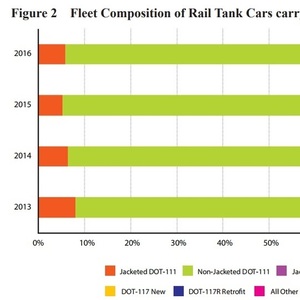DOT releases new rail tank car data

U.S. Department of Transportation
September 25, 2017
BY Erin Krueger
On Sept. 22, the U.S. Department of Transportation’s Bureau of Transportation Statistics released new data on the fleet composition of rail tank cars in 2013-2016 that transport flammable liquids, including ethanol.
The DOT is required to assemble and collect data on rail tank cars transporting Class 3 flammable liquids with the objective of tracking process made in upgrading the rail tank car fleet to new safety requirements. The reporting also provides an annual status report to Congress.
The DOE published a final rule unveiling enhanced tank car standards and a risk-based retrofitting schedule for older tank cars carrying crude oil and ethanol in May 2015. Ethanol cars must be retrofitted by mid-2023.
Advertisement
Advertisement
According to the DOT’s report, the total fleet of rail tank cars that carried Class 3 flammable liquids increased from 2013 through 2015, but fell in 2016. There were 78,512 rail tank cars in this service in 2013, increasing to 92,358 by 2015. In 2016, the fleet that actively carries Class 3 flammable liquids shrank, reaching 81,027.
From 2013-2016, the report shows that DOT-117s, both new and retrofitted, grew from zero to 7,181, representing 9 percent of the fleet. Non-jacketed Dot-111 rail cars remain the largest percentage of tank cars in this service. Their share, however, has dropped from 66 percent in 2013 to 53 percent in 2016. The DOT reported that from 2013 through 2016, the numbers of jacketed CPC-1232 tank cars increased, along with DOT-105, DOT-112, DOT-114, DOT-115, DOT-120 and DOT-211. The DOT said it expects all Class 3 flammable liquids will be carried in rail tank cars that meet or exceed the DOT-117 or DOT-117 R specifications by the 2029 deadline.
Advertisement
Advertisement
In 2013, 90.7 percent of tank cars were in single service, with 9.03 percent in multiple service. By 2016, only 85.9 percent of cars were in single service, with 14.1 percent in multiple service.
According to the report, the percentage of non-jacketed DOT-111s carrying ethanol increased from 46 percent in 2013 to 65 percent in 2016, despite the number of non-jacketed DOT-111s carrying ethanol staying relatively stable between 2014 and 2016. The percent of jacketed CPC-1232 cars carrying ethanol increased from 0 to 10 percent in 2016, while the percentage of non-jacketed CPC-1232 cars used for transporting ethanol increased from 3 percent to 20 percent in 2016.
The report also states that 70 percent, or 4,966, of the tank cars that meet the DOT-117 specification are new, while 30 percent, or 2,215, have been retrofitted. These DOT-117 and DOT-117R tank cars carry a variety of flammable liquids, but the report shows 41 percent carry crude oil and 46 percent carry ethanol.
A full copy of the report can be downloaded from the DOT website.
Related Stories
U.S. fuel ethanol capacity fell slightly in April, while biodiesel and renewable diesel capacity held steady, according to data released by the U.S. EIA on June 30. Feedstock consumption was down when compared to the previous month.
XCF Global Inc. on July 8 provided a production update on its flagship New Rise Reno facility, underscoring that the plant has successfully produced SAF, renewable diesel, and renewable naphtha during its initial ramp-up.
The U.S. EPA on July 8 hosted virtual public hearing to gather input on the agency’s recently released proposed rule to set 2026 and 2027 RFS RVOs. Members of the biofuel industry were among those to offer testimony during the event.
The USDA’s Risk Management Agency is implementing multiple changes to the Camelina pilot insurance program for the 2026 and succeeding crop years. The changes will expand coverage options and provide greater flexibility for producers.
EcoCeres Inc. has signed a multi-year agreement to supply British Airways with sustainable aviation fuel (SAF). The fuel will be produced from 100% waste-based biomass feedstock, such as used cooking oil (UCO).
Upcoming Events










